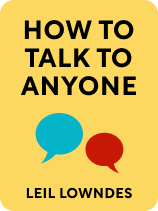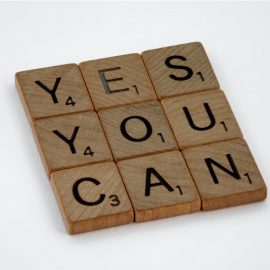

This article is an excerpt from the Shortform book guide to "How to Talk to Anyone" by Leil Lowndes. Shortform has the world's best summaries and analyses of books you should be reading.
Like this article? Sign up for a free trial here .
Do you consider yourself an approachable person? Do strangers often come up to you to strike a conversation? What are some things you can do to appear more approachable?
Being approachable can really change the game when it comes to your social life. If you appear approachable, more people will come up to you, leading to new friends, romantic encounters, and even professional opportunities.
Here’s how to be more approachable and appealing, according to communications expert Leil Lowndes.
How to Appear Approachable and Likable
Lowndes argues that in Western society, people instinctively know how to distinguish between nonverbal “I like you” signals and “Get away from me” signals. People gravitate toward those who appear to like them. Therefore, you can appear more approachable by becoming conscious of the signals your body language is sending and making sure they’re saying, “I like you.”
(Shortform note: As Lowndes says, her advice focuses solely on how Western society interprets body language. Nonverbal signals vary greatly across countries so it’s definitely worth researching them if you’re planning to engage with other cultures. For example, in America the thumbs-up sign is an indicator of agreement or a job well done. However, in Greece or the Middle East, it’s akin to using the middle finger.)
Lowndes decodes this silent language and explains how to be more approachable through the following five techniques.
Technique #1: Stand Tall
According to Lowndes, people interpret poor posture as an unwelcoming signal. Trying to minimize your physical presence by slumping implies that you’re insecure or ashamed and don’t want to be approached.
On the other hand, people interpret good posture as a welcoming signal because it implies that you’re proud and confident and have nothing to hide. This tricks them into assuming that you’re an accomplished person who deserves their attention.
(Shortform note: Research reveals that, in addition to making you appear more approachable, good posture makes you feel happier and more confident. Good posture increases levels of testosterone and decreases stress hormones, such as cortisol. These hormone changes make you feel more energetic and confident, increase your self-esteem, and lessen any social anxiety you feel. On the other hand, poor posture decreases your levels of testosterone and increases your cortisol levels. These hormone changes make you feel more fearful, sad, lonely, and sluggish—thus increasing your feelings of social anxiety.)
Technique #2: Relax and Remove Physical Barriers
Lowndes claims that people interpret fidgeting and guarded movements as insincerity because they make you look suspicious and defensive:
- Fidgety movements, such as shuffling your feet or touching your face, come across as signs of discomfort, tension, or distraction.
- Guarded movements, such as folding your arms or clutching something in front of your body, also convey discomfort. Additionally, they give the impression that you’re placing barriers between yourself and other people.
On the other hand, Lowndes argues, people interpret a relaxed and open stance as a sign of an honest and welcoming personality because it signals that you’re calm, unafraid of appearing vulnerable (because you have nothing to hide), and approachable. To come across as calm, self-assured, and trustworthy, practice keeping your arms loosely by your sides with your palms and wrists faced upwards. If you’re approached by people you want to talk to, turn your body totally towards them to show them they’ve got your full attention—this implies that you’re happy to be in their company and puts them at ease.
(Shortform note: Why keep your palms and wrists faced upwards? According to psychologists, primitive survival instincts lead you to unconsciously perceive closed or hidden palms as a sign of danger—if you can’t see someone’s hands, you don’t know if they’re holding a weapon. In addition to the open body language Lowndes describes, you can reduce uncertainty about your intentions by tilting your head to one side. Exposing your neck—one of the most vulnerable areas of your body—signals that you’re very comfortable around others and have no intention of causing harm.)
Technique #3: Delay Your Smiles and Maintain Eye Contact
According to Lowndes, people don’t respond warmly to quick, instinctive smiles because they interpret them as impersonal—they assume that you’re flashing that smile at anyone you come across. This impels them to respond in kind, by acting detached or distant.
Another behavior that puts people off, Lowndes argues, is a lack of eye contact. Others interpret it as a sign that you’re either distracted or uncomfortable, and this makes it difficult for them to form an emotional connection with you.
To get a warm response, Lowndes suggests that you avoid your instinct to flash a quick smile at anyone you meet. Instead, look the recipient in the eyes, pause briefly, and then let out a big warm smile while maintaining eye contact. The delay will convince recipients that you’re smiling just for them and they’ll instantly feel like you’re happy to meet them. As you continue your conversation, attempt to maintain a comfortable amount of eye contact to convince them that you’re interested in what they have to say.
Technique #4: Pretend You’re Already Close Friends
Lowndes suggests a way to automatically trick your body into sending positive signals: Pretend that you’re already close friends with the people you want to talk to. She argues that you only feel—and broadcast—discomfort when you’re feeling unsure about how others will respond to you. However, when you imagine that you’re already close friends, you remove this uncertainty and automatically feel more relaxed and comfortable around others.
According to Lowndes, pretending to like others feels so good that it eventually turns into genuine affection. While you’re initially only pretending to like them, you’re sending signals that put them at ease—encouraging them to like you and respond warmly to you. This makes you want to like them, resulting in a genuinely comfortable and enjoyable interaction.
Technique #5: Hold Their Gaze to Encourage Attraction
If you’re attracted to someone, instead of playing coy, hold their gaze for as long as possible. Lowndes argues that strong eye contact is more likely to invite a positive response because it makes the recipient feel like she’s captivated you. Your obvious interest in her triggers a nervous, biological response that’s similar to what happens when people fall in love: It increases her heartbeat and pumps adrenaline into her bloodstream. Because she’s not conscious of why she’s experiencing this nervous physical reaction, she interprets it as a sign of mutual attraction and intimacy.
To encourage attraction, maintain eye contact with your recipient even when others in your group are speaking. If you must look away, do so slowly and reluctantly—as if you’re so enthralled that you can’t look away. To make it less intense, let your eyes bounce between your recipient and back.
Lowndes warns that intense eye contact should be used with caution. If your intended recipient has already decided that she’s not attracted to you, she’ll interpret your attention as arrogance and won’t respond well. (Shortform note: Additionally, research shows that maintaining eye contact with too much intensity makes you come across as a psychopath.)

———End of Preview———
Like what you just read? Read the rest of the world's best book summary and analysis of Leil Lowndes's "How to Talk to Anyone" at Shortform .
Here's what you'll find in our full How to Talk to Anyone summary :
- Practical techniques to help you overcome social discomfort
- How to confidently develop new connections
- How to appear more likable without saying a word






